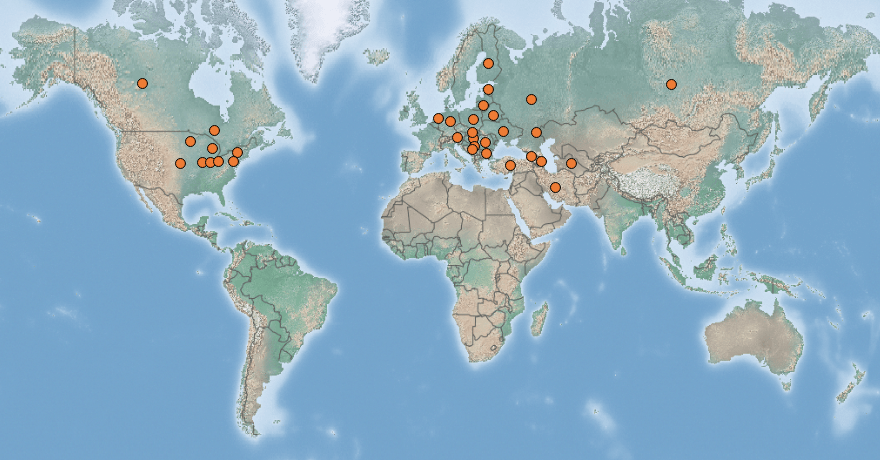 |
Round goby | Status LU: established. 1st record: ~2010. |
 |
Schwaarzmond-Grondel | Status Eur.: established. |
 |
Gobie à taches noires | RA: ISEIA: A2, Black List. Harmonia+: n/a. |
 |
Schwarzmund-Grundel | Wikipedia: |
 |
Zwartbekgrondel | Back to the list of vertebrates |
Contents
Report the species
→ Report Neogobius melanostomus to the National Museum of Natural History.
Brief description
 Neogobius melanostomus (Pallas, 1814) is a bottom dwelling fish that lives in slow brackish and fresh waters. It is typically found near rocky substrates, but also in fine gravel and sandy bottoms. The round goby is a voracious feeder of benthic freshwater invertebrates (e.g. bivalves) and small fishes. It has been reported to reduce populations of native fish through predation and food competition, its main advantage being its ability to feed in darkness. Adults may occupy the prime spawning areas and defend those sites aggressively, keeping natives out. The round goby may rapidly become a dominant fish species and may be responsible for fish species displacement and for the impoverishment of aquatic communities (Branquart & Verreycken 2014).
Neogobius melanostomus (Pallas, 1814) is a bottom dwelling fish that lives in slow brackish and fresh waters. It is typically found near rocky substrates, but also in fine gravel and sandy bottoms. The round goby is a voracious feeder of benthic freshwater invertebrates (e.g. bivalves) and small fishes. It has been reported to reduce populations of native fish through predation and food competition, its main advantage being its ability to feed in darkness. Adults may occupy the prime spawning areas and defend those sites aggressively, keeping natives out. The round goby may rapidly become a dominant fish species and may be responsible for fish species displacement and for the impoverishment of aquatic communities (Branquart & Verreycken 2014).
Status and distribution in Luxembourg
Records of Neogobius melanostomus (Pallas, 1814) in Luxembourg. Data source: Recorder-Lux, iNaturalist & GBIF, 2024-07-26.
On 27th July 2015, a parliamentary question was raised in the Luxembourg parliament about the invasion of Neogobius species in the Moselle river. This was echoed in the daily newspaper Tageblatt on the same day (Wildschutz 2015).
The distribution map is incomplete because records still have to be entered into the Recorder-Lux database (MNHNL, iNaturalist & GBIF 2019).
Risk assessment
ISEIA protocol
A2 (3+3+3+2) = Black List (Ries et al. 2014: 199).
Harmonia+ protocol
Not assessed yet.
Natural range and places of introduction

2014 by Yuriy Kvach. CC BY-SA 4.0, https://commons.wikimedia.org/w/index.php?curid=35153980
Worldwide distribution
Bibliography
-
- Branquart, E. & H. Verreycken, 2014. Harmonia database: Neogobius melanostomus (Pallas, 1814). Harmonia version 1.2, Belgian Forum on Invasive Species. URL: http://ias.biodiversity.be [accessed on 2019-10-24]
- CABI, 2019. Neogobius melanostomus (Pallas, 1814). In: Invasive Species Compendium. Wallingford, UK: CAB International. URL: www.cabi.org/isc [accessed 2020-04-22]
- Dohet, A., 2017. Personal communication. LIST.
- MNHNL, 2000-. Neogobius melanostomus (Pallas, 1814) in Recorder-Lux, database on the natural heritage of the Grand Duchy of Luxembourg. Musée national d’histoire naturelle, Luxembourg. URL: https://mdata.mnhn.lu [Accessed 2019-10-24]
- MNHNL, iNaturalist & GBIF, 2019. Neogobius melanostomus (Pallas, 1814) in MNHNL-mdata, online portal combining species observation from Recorder-Lux, iNaturalist and GBIF. National Museum of Natural History, Luxembourg. URL: https://mdata.mnhn.lu [Accessed 2019-10-24]
- Ries, C., M. Pfeiffenschneider, Engel, E., J.-C. Heidt & M. Lauff, 2014. Environmental impact assessment and black, watch and alert list classification after the ISEIA Protocol of vertebrates in Luxembourg. Bull. Soc. Nat. luxemb. 115: 195-201. [PDF 247 KB]
- Wildschutz, N., 2015. Grundel-Plage in der Mosel. Tageblatt online 27.07.2015. URL: http://www.tageblatt.lu/nachrichten/grundel-plage-in-der-mosel-16593303/ [2018.04.13]
Suggested citation of this webpage
Ries, C. & M. Pfeiffenschneider (Eds.), 2024. Neogobius melanostomus (Pallas, 1814). In: neobiota.lu - Invasive Alien Species in Luxembourg. National Museum of Natural History, Luxembourg. URL: https://neobiota.lu/neogobius-melanostomus/ [Accessed 2024-07-26].
Page content last updated on 2023-01-24. Last proofread by Caroline Grounds on 2019-11-27.


